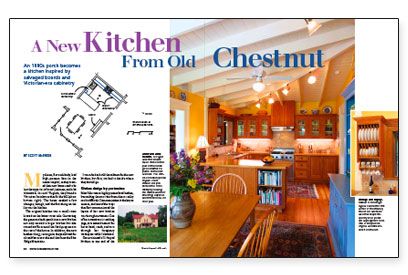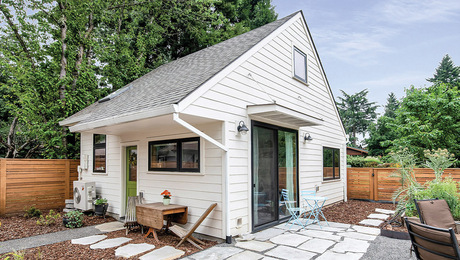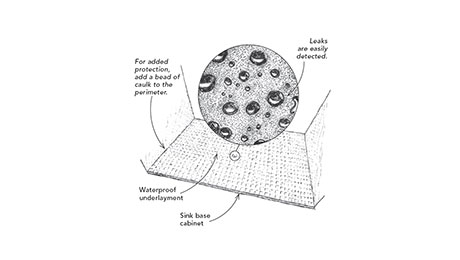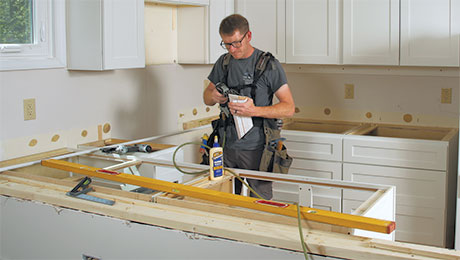A New Kitchen From Old Chestnut
An 1880s porch becomes a kitchen inspired by salvaged boards and Victorian-era cabinetry.

Synopsis: This remodeled kitchen in the Eastlake style features a combination of cabinets and open shelves, including an elegant dishrack. Wooden counters and floors are offset by yellow walls and a white cathedral ceiling. One sidebar discusses how the counters were finished and how they’re holding up over time. Another sidebar details the features that define the Eastlake style.
My clients, Bev and Andy, lead high-pressure lives in the nation’s capital, so they wanted their new homestead to be just the opposite: informal, intimate, and a bit whimsical. In rural Virginia, they found a Victorian farmhouse that fit the bill. The house needed a few changes, though, and the first thing on the list was the kitchen.
The original kitchen was a small room located on the home’s west side. Converting the generous back porch into a new kitchen not only created a larger kitchen but also routed traffic around the food-prep area to the rest of the house. In addition, the new kitchen’s long, rectangular shape allowed for a breakfast area at the end that faces the Blue Ridge Mountains.
I was asked to build the cabinets for the new kitchen, but first, we had to decide where they should go.
Kitchen design by pantomime
Most folks want a highly personalized kitchen, but making the transition from idea to reality can be difficult. Communication is the key to success, and one of the ways that Bev communicated the layout of her new kitchen was through movement. One of her avocations is teaching yoga, so it seemed natural for her to bend, reach, and turn through her imaginary workspace while I sketched.
She envisioned a U-shaped kitchen at one end of the room and a breakfast area overlooking the mountains at the other end. A peninsula separating the two would politely bar guests from the cook’s domain.
Eastlake styling inspires cabinets
While sifting through Bev’s pile of books and magazines for a winning cabinet style, one photo caught my eye. It was of a cabinet face frame, normally a plain background element, that had been transformed into a lively accent with reeded stiles butting squarely into beaded rails.
Mixing moulding profiles is typical of the Eastlake furniture style, and I thought it would look good on the cabinets of this late-19th century home. Without appearing overly busy, the Eastlake style pleases the eye with moulding details: reeded lines in face frame stiles, beaded face-frame rails, and mitered frames in doors and drawers.
In addition to mixing molding profiles, we decided on a few other details that would reinforce the Victorian flavor: inset doors hung on ball-tipped brass hinges and flat panels on cabinet doors. Inset doors require tedious fitting and hinge-mortising compared with overlay doors, but the old-fashioned look justifies the extra labor. As for the flat panels on the base-cabinet doors, I think that they look more authentic in a farmhouse than do raised panels. The upper doors have glass inserts.
For more photos, drawings, and details, click the View PDF button below:


























